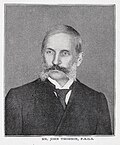File:REELING SILK 1.jpg

Original file (1,022 × 1,272 pixels, file size: 563 KB, MIME type: image/jpeg)
| This is a file from the Wikimedia Commons. Information from its description page there is shown below. Commons is a freely licensed media file repository. You can help. |
Summary
| DescriptionREELING SILK 1.jpg |
English: John Thomson: THE superstitious dread with which the people regarded my photographic apparatus rendered it impossible for me to obtain more than this single picture in the silk-producing districts, although I had made a special journey thither, with the intention of securing a full series to illustrate the various operations connected with this branch of industry. The mulberry grows to perfection in the Kwang-tung province, and is used extensively in the rearing of the silkworm. This business gives profitable Occupation to thousands of the families of small farmers, who set aside a portion of their gardens for the culture of the mulberry shrub. On the wives and daughters of the household falls the business of superintending the various delicate operations connected with the production of the silk — their duty it is to collect the eggs, to watch with care the process of hatching, which takes place in April, to nourish with the tender mulberry-leaves the tiny worm as he accomplishes his marvellous labours, and then, when he has finished his silken fabric, to arrest his career of industry, and wind off the cocoons for exportation to the looms of Europe. We owe much to China ; and perhaps a knowledge of the rearing of the silkworm, and the introduction of silk are two of the greatest boons she has conferred upon Western nations. It was one of my most interesting experiences in the country to observe how modest were the aspects of this wide-spread industry, and how humble, yet sedulous, were the poor labourers whose lowly toil results at last in robes so magnificent and so dearly prized. In the village where the photograph was taken, all the women, as well as the children of sufficient age, were engaged in reeling silk. The machines are of a very primitive make, the most advanced and perfect being the one here shown. The labourers will not permit the introduction of anything more complex ; and their guilds 'or trades' unions are so well organized that they can hold their own against their employers. This opposition offered by labourers in China to the introduction of new appliances that would tend to expedite labour is akin to what prevails in India. When extensive cuttings had to be made for railroads, the government furnished wheelbarrows to the coolies as a substitute for their small native baskets. The men used the wheelbarrows by placing a basketload in each, and marching off with the barrow mounted on the head. The Chinese workman is a very independent character, who, if he conceives he is wronged by his employer, has effectual means of redress. An English merchant in Hong-Kong gave me a striking example of the combined power of Chinese operatives. My friend had been in the habit of furnishing yellow metal in sheets of a certain thickness, to a coppersmith in Fatshan, the Birmingham of southern China. Some metal a shade thinner was offered — the smith said it would suit admirably, and would save labour. The thin metal, however, was submitted to the men, who at once decided to strike work were it introduced, as it would rob them of the time and labour consumed in beating metal of the old kind and shape, and thus give the master an undue advantage. The metal was accordingly rejected. |
||||||||||||||||||||
| Source | Beinecke Rare Book & Manuscript Library | ||||||||||||||||||||
| Author |
creator QS:P170,Q736862 |
||||||||||||||||||||
Licensing
| Public domainPublic domainfalsefalse |
|
This work is in the public domain in its country of origin and other countries and areas where the copyright term is the author's life plus 70 years or fewer.
| |
| This file has been identified as being free of known restrictions under copyright law, including all related and neighboring rights. | |
https://creativecommons.org/publicdomain/mark/1.0/PDMCreative Commons Public Domain Mark 1.0falsefalse
File history
Click on a date/time to view the file as it appeared at that time.
| Date/Time | Thumbnail | Dimensions | User | Comment | |
|---|---|---|---|---|---|
| current | 10:06, 21 January 2014 |  | 1,022 × 1,272 (563 KB) | 維基小霸王 | User created page with UploadWizard |
File usage
The following 2 pages use this file:
Metadata
This file contains additional information, probably added from the digital camera or scanner used to create or digitize it.
If the file has been modified from its original state, some details may not fully reflect the modified file.
| Width | 4,226 px |
|---|---|
| Height | 5,690 px |
| Bits per component |
|
| Pixel composition | RGB |
| Orientation | Normal |
| Number of components | 3 |
| Horizontal resolution | 72 dpi |
| Vertical resolution | 72 dpi |
| Software used | Adobe Photoshop CS6 (Windows) |
| File change date and time | 17:34, 21 January 2014 |
| Exif version | 2.21 |
| Color space | Uncalibrated |
| Unique ID of original document | 58C351E7F52240F7289F4D6746CCF9A5 |
| Date and time of digitizing | 00:14, 22 January 2014 |
| Date metadata was last modified | 01:34, 22 January 2014 |
| IIM version | 37,831 |
